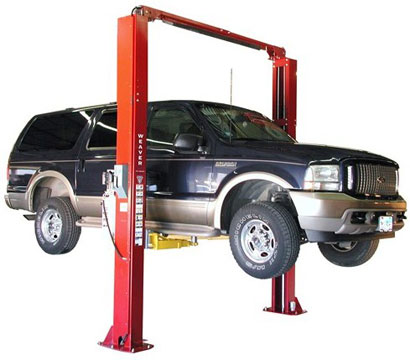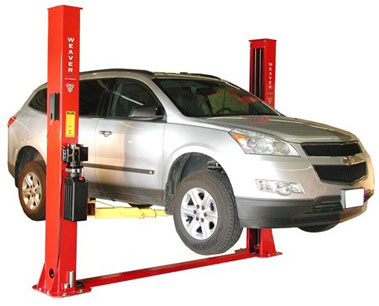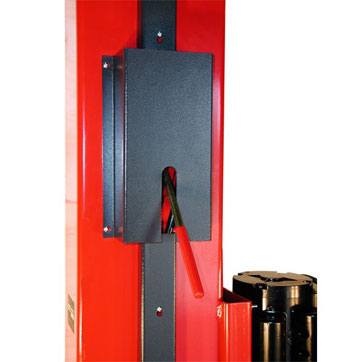To begin understanding the differences between symmetric vs asymmetric vehicle lifts and their features, we need to define each and how they apply to the 2 post automotive lift. The term symmetric is used in reference to features of lifts including the lift arms, columns, and loading. It’s important to consider the difference between asymmetrical and symmetrical lifts before choosing one for your shop since it’ll depend on what types of vehicles you’re working on.
Symmetric Lifts
For Lift Arms, the term symmetric means that all 4 arms are of equal length and the vehicle will essentially be loaded 50/50 on the lift.
For Lift Columns, the term symmetric means that the columns are squarely facing each other (not turned on an angle).
For Loading, the arms are positioned parallel in the front and parallel in the back allowing the vehicle to enter with the most drive through clearance. Once the vehicle is in position, the arms are swung in to reach each lifting point under the vehicle with equal weight on each arm.

Symmetric Lift Columns with Symmetric Lift Arms
Asymmetric Lifts
For Lift Arms, the term asymmetric means the four arms are not of equal length. Asymmetric lift arms will have 2 equal length shorter arms toward the front of the vehicle and 2 equal length longer arms towards the rear. The vehicle will essentially be loaded 30/70 on the lift with equal weight on each arm. This creates an offset towards the rear of the lift allowing the car door to open easier behind the column on narrower lifts.
For Lift Columns, the term asymmetric means that the columns have either been turned on an angle facing more towards the rear of the vehicle or the column has been manufactured with a built in angle facing more towards the rear. This allows a different load angle for lifting a vehicle asymmetrically.
For Loading, the arms are folded back towards the rear of the lift to allow the vehicle to enter the lift. Once the vehicle is in position, the arms are swung in to reach each lifting point under the vehicle with equal weight on each arm.

Asymmetric Lift Columns with Asymmetric Lift Arms
Super Symmetric Lifts
For Lift Arms, the term supersymmetric means that the front arms telescope in 3 stages and the rear arms telescope in 2 stages. The 3 stage front arms and 2 stage rear arms allow both asymmetric and symmetric lifting methods. The 3 stage arm can retract short enough for asymmetric loading and yet extend long enough to reach frames for symmetric loading. The vehicle can essentially be loaded 50/50 or 30/70 with equal weight on each arm.
For Lift Columns, the term Supersymmetric does not apply. Lifts with supersymmetric arms are typically found on columns that are symmetric. This allows the most width between the columns providing better flexibility for both lifting methods and drive through clearance.
For Loading, the arms are positioned parallel in the front and parallel in the back allowing the vehicle to enter with the most drive through clearance. Once the vehicle is in position, the arms are swung in to reach each lifting point under the vehicle with equal weight on each arm.

SuperSymmetric Lift Arms with Symmetric Columns
Choosing between a symmetrical or asymmetrical lift along with the features they offer can limit or expand your product offerings if you’re looking to incorporate a lift into your home garage or commercial shop. There’s also a difference between baseplate vs. overhead 2-post lifts which are largely dependent on the height of the building you’ll be installing your lift in.
Baseplate vs Overhead 2 Post Lifts
Baseplate Lifts
The 2-post baseplate lift style utilizes a floor plate to cover the hydraulic hose and cables that run between the 2 posts. This plate (hence the name baseplate) is only 1” in height and has become lower and lower over time to become less of an obstacle than in early years. The baseplate is ramped on each side to allow for easy rollover for vehicles, jacks, toolboxes and other shop equipment.
2-Post baseplate lifts offer features that allow the lift to be installed under lower ceiling heights than overhead models. Most baseplate designs can be installed under a 10-foot ceiling because of the shorter column height. The typical baseplate column is 9’3” in overall height.
Note: The ceiling may become the height limitation for lifting some vehicles because the vehicle could travel up higher than the columns.

Baseplate Style 2 Post Auto Lift with SuperSymmetric Arms
Lift arms used on baseplate lifts are typically symmetrical due to presence of the baseplate. Using asymmetric arms is not available because the baseplate will not allow the asymmetric front arms to fold back towards the rear for loading. However, SuperSymmetric arms have become a popular choice because the 3 stage front arms are shorter and can still lift asymmetrically on some vehicles.
Using SuperSymmetric arms on a baseplate lift does not mean you can load any vehicle asymmetrically. Pay attention that the weight is place equally on each of the 4 arms.
Overhead Lifts
2-post overhead lifts are available in many variations and heights. The most common height for overhead lifts will allow the lift to fit under a 12’ ceiling. Thus, the overall height is typically around 142” or 11’ 10”. Some models offer the ability to be raised during installation to a secondary height setting if more ceiling height is available. This higher setting can help on some taller vehicles, but most common trucks and vans are fine with the lower setting. If you have the space you might as well use it, right? Just be sure you're positioning the lift in the shop properly. Overhead lifts can also be as tall as 14’ in higher capacity models used for utility and heavier service trucks.
With the overhead design, the hydraulic hose and cables are run through the overhead beam to each column. One benefit of doing this is it leaves a clear floor between the columns. This leaves the floor clear of obstructions for rolling jacks, toolboxes, and other shop equipment between the lift columns. The overhead beam will also have an overhead shut-off bar or cable mounted just below the beam. This device will shut off the motor if a vehicle is raised high enough to contact it thus preventing the vehicle from hitting the beam.

Overhead 2 Post Auto Lift with Symmetric Columns and SuperSymmetric Arms
Lift arms for overhead models can vary between all 3 types; symmetric, asymmetric and SuperSymmetric. With all these choices available it is easy to see why the overhead models are so popular. This flexibility gives larger shops a lot of options for lifting different types of vehicles. Columns are also flexible for overhead models with available symmetric or asymmetric types.
Single Point and Dual Point Safety Locks
Safety lock styles can come in one of two different types on 2 post auto lifts - single or dual point lock release.
Single Point Lock Release
Single point lock release is a feature that saves time and effort to release the safety locks when you are ready to lower the vehicle. All lifts have safety locks that engage every 2-4 inches as the lift is raised. When the desired height is reached, the lift is lowered into the nearest lock position. After the work is completed and you are clear to lower the lift, two things need to happen.
- First, the lift needs to be raised up enough to disengage from the locked position.
- The second is to release or disengage the lock system on each column so the lift can be lowered with the lowering handle on the power unit. The lock release lever is held while lowering to prevent the locks from locking until the lowered position is reached. So one hand is holding the locks disengaged at the single point lock release while the other is lowering the lift with the lowering handle on the power unit. On a single point lock release the operator simply has one lever to move to unlock the locks in both columns. This lever is connected to the two locks by means of a cable. When the lever is moved the cable will provide the same action for both column locks. The single point lock release lever is located on the same column as the power unit for ease of operation of all lift controls.

Single Point Lock Release Lever Controls Both Column Locks From One Side
Dual Point Lock Release
Dual Point Lock Release systems have pull type releases located on each column or lift carriage. This requires the operator to go to each column to pull the release before lowering. The lock will stay disengaged until the lift is raised again. Once the lift begins to raise again the locks will reset and start locking again.
Note: The dual lock system works differently than the single point type in two ways. First, the locks stay disengaged once they are released so the operator can go to the power unit to lower the lift. Second, the dual point locks do not engage again until the lift is raised. On a single point lock system the locks will engage again after you let go of the lever.
Related:

